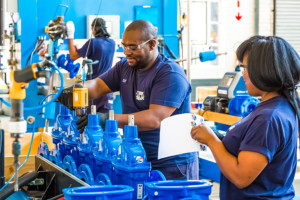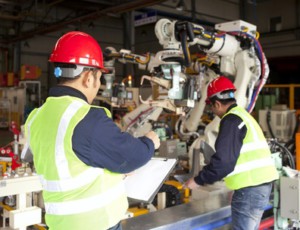 This post is on a topic you probably all have had experience with at one point or another (or even all the time) in your career. A superior makes a decision, and you are internally wincing because you know right away that it is a really bad idea. In this post I would like to talk about uncertainty and decision making, and how to make better suggestions. If you are a regular reader of my posts, you probably already know the answer: Involve the employees! This post is a continuation of my previous post on military leadership.
This post is on a topic you probably all have had experience with at one point or another (or even all the time) in your career. A superior makes a decision, and you are internally wincing because you know right away that it is a really bad idea. In this post I would like to talk about uncertainty and decision making, and how to make better suggestions. If you are a regular reader of my posts, you probably already know the answer: Involve the employees! This post is a continuation of my previous post on military leadership.
Introduction
 In my previous post, I described that the military believes in a strong structure of command and control. The officer orders and the soldier follows the order… except, often they don’t. There may be different levels of disobedience that actually may be beneficial. Using soldiers only to execute orders will fall far short of the possibilities.
In my previous post, I described that the military believes in a strong structure of command and control. The officer orders and the soldier follows the order… except, often they don’t. There may be different levels of disobedience that actually may be beneficial. Using soldiers only to execute orders will fall far short of the possibilities.
Who Knows Best?
 This is also true for manufacturing. Larger decisions should not be made by a single person. Plus, the people closest to the actual location (i.e., the Gemba) often know best. A lean improvement project on the shop floor touches the usually very complex production system, with lots of technical and organizational details. Mess any of them up, and the “improvement” may make it worse.
This is also true for manufacturing. Larger decisions should not be made by a single person. Plus, the people closest to the actual location (i.e., the Gemba) often know best. A lean improvement project on the shop floor touches the usually very complex production system, with lots of technical and organizational details. Mess any of them up, and the “improvement” may make it worse.
Even though the salary does not always reflect it, manufacturing does require skills. Every new employee will take some time to get up to speed, and even more time to become really good at their machine. If you don’t believe it, go to your shop floor, pick a manual process, and try to do it. You may be able to do it, but much slower than any of the people doing it daily for the last five years.
The workers also have a good “feel” of the process. A good example is your car. If you use your car regularly, you will probably notice a minor quirk in the steering, or a slightly odd sound from the engine or transmission, quickly. In a rental car you wouldn’t notice, because you do not know what a normal process sounds like. Similar in manufacturing, the operators know their process best.
Why to Involve Multiple People
 I am not saying that the shop floor workers have all the answers. Definitely not. In all likelihood, nobody knows all the details.
I am not saying that the shop floor workers have all the answers. Definitely not. In all likelihood, nobody knows all the details.
You have workers on the shop floor who know how the process will react to changes, and can often estimate the impact on their work (although some workers may have an overly pessimistic view). You have logistics people who can estimate the impact on the material flow. You have maintenance and programming who can determine if it is doable technically. And you have managers (yes, they do serve a purpose too!) who can determine whether the improvement is aligned with the overall goals of the company. Management is also needed to enable and support the improvement process in the first place.
Therefore, if you involve people from the different factions and stakeholders, you have a much better chance of getting all the relevant information. This helps not only to figure out what does not work, but can also give additional ideas for things that may work even better!
How to Involve Multiple People
 The simplest way to involve multiple people is to have a number of checkboxes or signatures, and everybody signs off on the project. But this is worthless, as due to time pressure very few will actually look at the documents in detail. Upper management, for example, signs dozens or hundreds of documents daily, hoping that the secretary did prepare the signature stack well and none of the signatures will blow up in their face. A simple signature checklist is a waste of time.
The simplest way to involve multiple people is to have a number of checkboxes or signatures, and everybody signs off on the project. But this is worthless, as due to time pressure very few will actually look at the documents in detail. Upper management, for example, signs dozens or hundreds of documents daily, hoping that the secretary did prepare the signature stack well and none of the signatures will blow up in their face. A simple signature checklist is a waste of time.
It is much better (albeit much more time consuming) to involve the people in the development of the improvement project. From the beginning with the analysis of the problem to the development of the solutions, selection and improvement of the solutions, to the implementation and finally the verification (PDCA), representatives of the different stakeholders should be involved. This way they not only can find potential problems, but also potential solutions. Involving the operators also increases the buy-in and the likelihood of acceptance by the shop floor. I actually wrote an entire post on My Workshop Structure for Creative Problem Solving.
There may also be minor projects where a single person can do the work, but this is probably rare.
Why Leadership (Often) Does Not Like It
 Involving the shop floor workers can significantly improve the outcome of the project, or make it possible in the first place. However, some managers have difficulties with this. There is of course the time pressure – involving multiple people takes more time than a single decision maker. But often, the expected behavior of the manager may clash with asking the workers. Let me go a little bit deeper on this.
Involving the shop floor workers can significantly improve the outcome of the project, or make it possible in the first place. However, some managers have difficulties with this. There is of course the time pressure – involving multiple people takes more time than a single decision maker. But often, the expected behavior of the manager may clash with asking the workers. Let me go a little bit deeper on this.
Management is not easy. Everybody wants something from you (a raise, cheaper products, better quality, stock market performance, …), while the manager has limited time and has to make his decisions with often great uncertainty on the outcome (will the new product be a success or a flop?). No, definitely not easy.
Additionally, managers are often under constant scrutiny. Mess up, and it may impact your career. Look weak, and a more decisive fellow manager may get the promotion. And that is (often) the problem here. Managers usually can ill-afford to look weak. On top of this, managers often have a lot of insecurity due to the uncertainty, although usually well hidden (most sane managers constantly worry if the decision is the right one – it is the managers that do not worry who concern me).
 As a result, managers feel they have to make decisions, even if it would be better if someone else makes the decision. Anyone questioning their decisions may make them look weak, and (some) managers use their power to oppress any critical questions or negative feedback, even if it is fully justified. You probably know such a manager who collects yes-men (and women) around them who support his decisions no matter what. In my view, the culture in the company selects its managers accordingly, and there are some companies where you need to look tough to advance, and others where it is more based on actual results (not only presented results, mind you).
As a result, managers feel they have to make decisions, even if it would be better if someone else makes the decision. Anyone questioning their decisions may make them look weak, and (some) managers use their power to oppress any critical questions or negative feedback, even if it is fully justified. You probably know such a manager who collects yes-men (and women) around them who support his decisions no matter what. In my view, the culture in the company selects its managers accordingly, and there are some companies where you need to look tough to advance, and others where it is more based on actual results (not only presented results, mind you).
Luckily, there are also managers who do a much better job of involving the employees, getting their input, and respecting their people. Hopefully you are such a manager, and/or working under such a manager. Now, go out, involve your people, and organize your industry!

Early Employee involvement clearly will ensure and create most of any project. No doubt about it.
While having one person make a final decision can be a good thing to ensure action takes place instead of a back and forth between opposing parties. It is always critical for that individual to get as much feedback and input as possible before making that final decision. This ensures the most people will feel comfortable, or at the least will not be caught off guard when change occurs.
Hello Tim, good point. Get all the input, then make the decision. Some bosses, however, are very resistant against opinions and facts other than their own (opinion?).
One simple question I like to use with team members is this. What bugs you about your job function, how can we improve it? This engages the team members, when engagement occurs it encourages employee buy-in. Once you help them successfully remove these roadblocks, you will be surprised at how this one question will quickly improve your Value Stream.
Hello Bob, this was also something we did often with consulting projects: Ask the people on the shop floor what should be changed/improved. We got lots of insights from that (and of course the occasional complaint about things that can’t be changed)
Involving the people on the shop floor is so important it leads to a more successful form of leadership. By listening to employees more closely management can then ensure that issues can be addressed and solved in a quick manner. However this is not easily achieved like you mentioned in the post management is not a simple task but when done in the right way can lead to great successes throughout companies.
Hi Christoph, lean manufacturing organisation which is a team of approx. 5 people led by a team leader provides a structure which facilitates involvement and group decision making.
Süleyman, I agree. good team sizes are anywhere between 3 and 5 people, after that you start to have spectators rather than participants, unless you can break it into smaller sub-teams.
Managers do not always have to make decisions, in some cases it would be better to either have the employee who is an expertise on that specific issue or to have a collective group decision. Like stated in the post, managers are always busy helping everyone out so by making one manager make the decisions, it can be overwhelming.